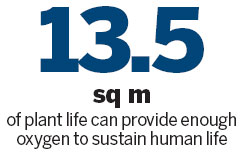Growing food in space could assist in human colonization
By Zhang Lei (China Daily) Updated: 2014-01-06 07:53Harmonious relationship
Although the results can be highly variable, Darwin's theory of the "survival of the fittest" suggests that the surviving plants will be capable of adapting through mutation and ultimately forming a harmonious relationship with the exo-environment.
Last year, China completed its ninth series of experiments into exo-cultivation. "We've been working on hydroponic cultivation, using a closed or semi-open space, to grow edible plants," said Fu. He was unable to elaborate further because the details of the project are classified, but he emphasized that success is often dependant on close cooperation between exo-scientists and botanists.
"First, we have to select the appropriate growing media, usually an agar nutrient. The selected plants must have highly efficient photosynthetic processes so they will absorb some carbon dioxide, but release large amounts of oxygen," he said.
"They must also have a continuous growth cycle and high sustainability, be nutritious and taste good. They shouldn't cause environmental pollution or any other unwanted effects, and should be capable of growing in limited amounts of sunlight or artificial light."
In 2012, two test subjects from the China Astronaut Research and Training Center spent 30 days living in Yuegong-1. In the 36-square-meter self-contained lab, Tang Yongkang and Mi Tao breathed oxygen produced by the Chinese cabbages and lettuce being grown under the powerful lights. They also picked 30 to 50 grams of fresh vegetables for their daily meals.
The test proved that in a planted area of just 13.5 sq m, the "human to plant" exchanges of oxygen and carbon dioxide, in tandem with technology to control the internal equilibrium of the plants, can provide enough oxygen to sustain human life. The plants, which must share a symbiotic relationship, replenish the supply of oxygen while disposing of the harmful carbon dioxide produced during respiration.
In Russia, experiments have been conducted in simulated exo-environments for 14 years. The results indicate that 63 sq m of plant life can provide roughly 70 percent of the daily food intake of three people.
Chinese scientists originally investigated the properties of a type of single-cell algae with high levels of carbon dioxide absorption and oxygen release, but the "food" produced had an unpleasant taste and relatively low nutritional value.
Research to identify plants with a strong absorption capability plus a large number of nutrients is an ongoing project and attention has now shifted to mushrooms, yeast and different varieties of algae, including chlorella. Azolla, a plant from the aquatic fern family, is likely to come under scrutiny during the next batch of tests.
Li Yinxin proposed using the human waste from containers on manned spacecraft as a medium to conduct tests into cultivation in high-salt soils.
"Astronauts' bodily fluids and excrement usually contain high concentrations of salt, especially nitrogen, but plants generally can't survive in a high-salt environment. If we can collect these specific data, the targeted research will be more effective. My experience of working on islands suggests that chenopodiaceae (also known as "Goosefoot", a family of plants that includes beetroot and spinach, which also have very high tolerance of salty soil) may be suitable because islands are also high-salt regions. We also cultivated salicornia (succulents that also display a high resistance to salt) on some of the Xisha Islands and achieved a high survival rate," she said.
- More female officials caught in corruption
- Whampoa veterans recorded with glory
- Police bust 9 terrorist groups in Xinjiang
- Knife-wielding attackers seized in Xinjiang
- New regulation leads to drop in petitioned cases
- Hunan plant shut as probe into lead poisoning begins
- Police boost efforts to combat gambling
- Project offers jobs openings to legal experts
- Experts: Dog meat festival 'illegal'
- Nation looks to upgrade
pipeline networks







